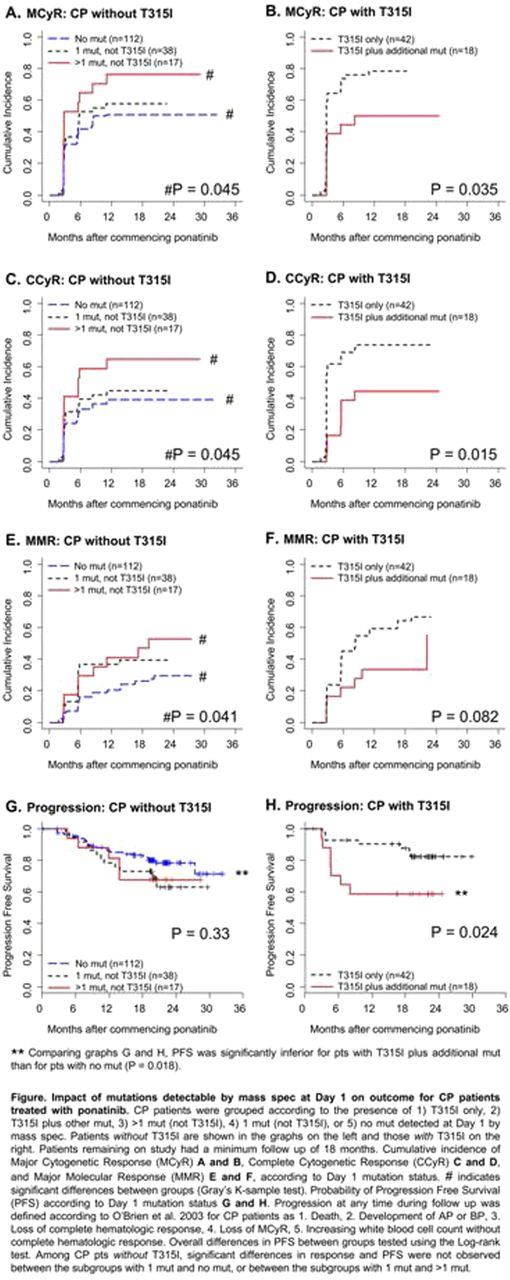Abstract
BCR-ABL1 mutations (muts) frequently cause resistance to tyrosine kinase inhibitors (TKIs) in CML. T315I, the most common mut, confers resistance to 1st and 2nd generation TKIs. In vitro studies suggest that all common individual muts are sensitive to the pan-BCR-ABL1 TKI ponatinib, and durable responses have been observed in patients (pts) with T315I. We have shown that low level muts below the detection limit of Sanger sequencing (SS) are important clinically, and that pts with >1 mut are a poor risk subgroup with lower CCyR and MMR rates and higher risk of treatment failure on 2nd-line therapy with nilotinib or dasatinib (Parker Blood 2012).
To determine whether the presence of low level BCR-ABL1 muts detected by mass spectrometry (mass spec) adversely impacts response to ponatinib.
We assessed 376 of the 392 pts treated with ponatinib in the phase II PACE trial who consented for sensitive mass spec mut analysis (detects 32 muts, limit ∼0.2%; 240 CP, 77 AP, 42 BP, 17 Ph+ ALL). RNA from samples collected at trial Day 1 were received from the commercial lab that performed SS. We performed mass spec analysis on duplicate cDNA samples blinded to the SS results. Muts were considered present if detected in both replicates. Cumulative incidence of MCyR, CCyR and MMR were calculated and tested with Gray's K-sample test. Progression free survival (PFS) was assessed by Kaplan-Meier with the log-rank test. 146 pts had disease progression. Mut analysis was performed by SS at discontinuation for 98 pts at the commercial lab. Pts remaining on study had a minimum follow up of 18 months (mo).
Of the 376 pts, 373 were evaluable at Day 1 by SS, and 359 by mass spec. Muts (242) were detected in 196 pts (53%) by SS. Among these muts, 95% were included in the mass spec assay and were potentially detectable; mass spec detected all but 6. At Day 1, >1 mut was detected in more pts by mass spec (64, up to 8 per pt) than SS (42, up to 3 per patient), 17% v 11%. T315I was the most common mut detected. Using mass spec, we detected an additional 12 pts with T315I compared with SS (107 v 95). Of these pts, 73 had T315I only and 34 had T315I plus at least 1 additional mut by mass spec. By SS, 75 pts had T315I only and 20 had T315I plus another mut.
At Day 1, mass spec detected 77 low level muts in 53 pts that were not detected by SS. Mut analysis was performed at discontinuation for 10/53 pts. In contrast to our previous studies where certain low level mutants known to confer resistance rapidly expanded with 2nd generation TKI treatment after imatinib resistance, only 2 of the low level mutants expanded during ponatinib therapy and were detected by SS at discontinuation (2 T315I). This supports the pan-BCR-ABL1 inhibition predicted from pre-clinical studies.
To investigate relationships between mass spec mut status and response and PFS, pts were grouped according to presence of 1) T315I only, 2) T315I plus additional mut, 3) >1 mut (not T315I), 4) 1 mut (not T315I), 5) no mut. The cumulative incidence of MCyR, CCyR and MMR and probability of PFS for AP, BP and Ph+ ALL pts was not significantly different according to mut status. However, among CP pts, significant differences were seen for response and PFS (Figure).
Among the CP pts without T315I, pts with no mut had significantly inferior cytogenetic and molecular responses than pts with >1 mut, but PFS was not significantly different.
For CP pts with T315I, the presence of additional mut was associated with significantly inferior cytogenetic responses and PFS. At 18mo, the cumulative incidence of MCyR, CCyR and MMR for pts with T315I only was 76%, 74% and 64%, respectively, whereas it was 50%, 44% and 33%, respectively, for pts with T315I plus additional mut. PFS at 18 mo was 88% for pts with T315I only, compared with 59% for pts with T315I plus additional mut. Notably, 56% (10/18) of CP pts with T315I plus additional mut as determined by mass spec were not classed as such by SS.
Mass spec identified a subgroup of CP pts with the T315I mut who had relatively inferior responses and outcome. These pts had T315I plus additional mut at Day 1 by mass spec. These pts also had inferior PFS as compared to pts without muts. Multiple muts in pts with T315I may be a marker of longer disease duration or poor disease control, but suggests that BCR-ABL1 mut status determined by mass spec has prognostic value. Ponatinib may overcome the poor responses to 2nd generation TKIs observed for pts with >1 mut without T315I and for pts with a single T315I mut.
Yeung:Novartis: Honoraria, Research Funding; BMS: Honoraria. Lustgarten:ARIAD: employees of and own stock/stock options in ARIAD Pharmaceuticals, Inc Other, Employment. Hodgson:ARIAD: Employment, Equity Ownership. Rivera:ARIAD: Employment, Equity Ownership. Hughes:Novartis: Honoraria, Membership on an entity’s Board of Directors or advisory committees, Research Funding, Speakers Bureau; BMS: Honoraria, Membership on an entity’s Board of Directors or advisory committees, Research Funding; Ariad: Honoraria, Membership on an entity’s Board of Directors or advisory committees, Research Funding. Branford:Novartis: Honoraria, Research Funding; BMS: Honoraria, Research Funding; Ariad: Honoraria, Research Funding.
Author notes
Asterisk with author names denotes non-ASH members.


This feature is available to Subscribers Only
Sign In or Create an Account Close Modal